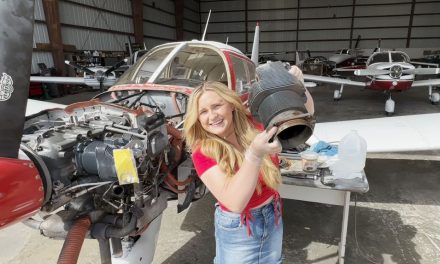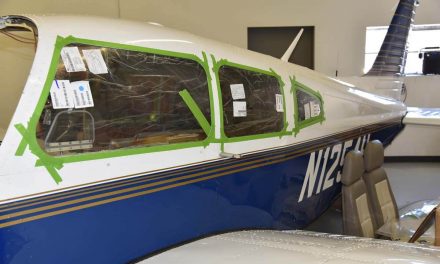A recent accident involving an in-flight propeller failure and separation has again brought to light the need for continued diligence in the use of liquid penetrant inspection methods. These methods involve the use of Type I fluorescent penetrants (visible under ultraviolet light) and Type II visible penetrant (visible under ordinary white light), (Ref. Aerospace Material Specification (AMS) 2644 Inspection Material, Penetrant). During the examination of the failed propeller, there were remnants of visible dye penetrant (red dye) material found in the bolt holes, which may have affected subsequent inspections.
At this time, the airworthiness concern is not an unsafe condition that would warrant any additional airworthiness directive (AD) action under Title 14 of the Code of Federal Regulations (14 CFR) part 39.
Background
Since at least 2000, the FAA has published the position that visible dye penetrant using ordinary white light is not recommended for the inspection of safety critical engine, propeller, or auxiliary power unit (APU) hardware. (Ref. Policy Memo PS-ANE100-2000-00010).
The picture captures a propeller from an accident. As can be seen, the accident propeller was a single-piece, aluminum, fixed-pitched model. Although the airplane was destroyed, the two occupants survived with serious injuries.
The accident propeller is subject to repetitive inspections in accordance with Airworthiness Directive (AD) 82-27-01. The AD inspections require the use of “dye penetrant inspection methods.” The AD uses generic terminology with no preference towards fluorescent dye (Type I) or visible dye (Type II) penetrants. This propeller was inspected per the AD, 77 hours prior to the propeller failure and in-flight separation. It was determined that fluorescent dye penetrant was used during the inspection.
In the photograph, you can observe residual visible red dye penetrant in some of the propeller hub holes from a prior inspection. It was concluded that post inspection cleaning after the use of red dye was not adequate and did not remove all of the red dye material. Fluorescent dye penetrant was used for the last AD inspection just prior to the propeller failure. Fluorescent penetrant inspection loses effectiveness when there is improper cleaning of red dye from a previous inspection. Visible dye material residue can be extremely difficult to remove and can fill voids, flaws, and cracks, which can affect subsequent inspections. Visible dye residue contamination of fluorescent penetrant fluid is also known to significantly reduce the brightness of fluorescent indication and can mask the fluorescent agent, causing flaws in the part to be minimized or missed at the next inspection.
Due to these characteristics, visible dye penetrants can make existing cracks nearly impossible to detect when using fluorescent penetrant inspection for the next inspection. Pre- and post-inspection cleaning is critical to ensure the ability to detect cracks during current and follow-on inspections and is essential to ensure proper detection of the anomalies and cracks in the article. Inspection material residuals can also lead to corrosion.
Recommendations
The FAA recommends the following:
- Be aware of the risks associated with using visible dye penetrant inspection methods.
- Per FAA policy, do not use visible dye penetrant using ordinary white light for the inspection of safety critical engine, propeller, or APU hardware. (Ref. Policy Memo PS-ANE100-2000-00010).
- Review the information in any AD requiring “dye penetrant” or “liquid penetrant” inspection of any safety critical part and follow the AD instructions, and/or the design approval holders (DAH) Instructions for Continued Airworthiness (ICA) with respect to inspection methods, materials, and techniques. Contact the DAH for assistance with their approved inspection methods. However, it should be noted that if there are any discrepancies between any AD and the DAH ICA’s, the AD takes precedence without an alternative method of compliance from the FAA office that issued the AD.
- Adhere to the prohibition contained in American Society for Testing and Materials
- (ASTM E 1471), which prohibits the use of Type II visible dye penetrant prior to the use of Type I fluorescent penetrants for the same surface.
- Adhere to the DAH pre- and post-inspection cleaning methods and materials to ensure any residual developer, penetrant, and/or visible dye residues are removed which could affect subsequent inspections.
For Further Information / Contact
Thomas Teplik, Aerospace Engineer, 1801 Airport Road, Rm. 100, Wichita, KS; phone: (316) 946-4196; fax: (316) 946-4107; e-mail: thomas.teplik@faa.gov.
The rest of this article can be seen only by paid members who are logged in.Have a website login already? Log in and start reading now.
Never created a website login before? Find your Customer Number (it’s on your mailing label) and register here.
Still have questions? Contact us here.





